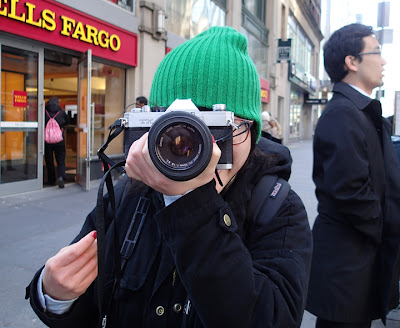Pentax MX-1: Hands-On Review and Sample Images
 |
| The MX-1 in All Black. |
Pentax has entered the “serious” high end compact digital camera market with the new MX-1, a retro-styled camera with a fast f/1.8-2.5 zoom and a competitive 12 Megapixel 1/1.7” sensor. Available in silver and black or all black for $499.95, the MX-1 comes in next to the standout retro designs from Olympus (with its OM-D EM-5 and XZ-series) and FujiFilm (with its X-series).
Specs
The fast SMC f/1.8-2.5 lens includes 4 aspherical elements and covers a strong 28-112mm
35mm-equivalent zoom range. Rounding out the MX-1’s spec sheet is ISO sensitivity to 12800, a (very bright and crystal clear) 3” 920k tilting LCD,
macro shooting to 1cm, “shake reduction,” and, naturally, full HD movie
shooting.
Brass Plates
 |
| The MX-1 in Silver & Black; the Silver portions are brass. |
The buzz surrounding the camera is its use
of brass top and bottom plates, which harken back to Pentax’s tough and
reliable (film) SLR’s—and which complement its tough, highly water-resistant
DSLR’s. Indeed, that most reviews must state
that Pentax is using “real” or “actual” brass serves to punctuate this unique
feature; the spin is that the brass will get “brassy”—show wear—over time, a
somewhat odd pitch given the inherent turnover of digital cameras.
The MX-1’s brass plates certainly feel more durable than plastic, aluminum or even some magnesium offerings, and the faux-leather rubber surface is nice and grippy—and it had better be, since there is neither a front nor a rear thumb grip, making the camera feel a bit loose especially considering its size and weight.
The MX-1’s brass plates certainly feel more durable than plastic, aluminum or even some magnesium offerings, and the faux-leather rubber surface is nice and grippy—and it had better be, since there is neither a front nor a rear thumb grip, making the camera feel a bit loose especially considering its size and weight.
In the Field
It seems that the MX-1’s retro-styling comes at a cost,
however: there’s no hot-shoe on the top
plate (and the pop-up flash is manually controlled) or options for an electronic viewfinder (EVF), no wheel surrounding the
lens for aperture control or manual focusing, and there is only a single dial on the back of the camera for spinning
through various settings (so that true manual shooters must use the same dial
for speed and aperture controls, although most typically shoot in Aperture
Priority (Av)).
Yes, the small buttons
on the back of the camera are quite well-spaced and well-designed and an
Exposure Compensation dial sits atop the camera, but there is still a feeling
of lack of control.
On the positive side, the LCD is very, very clear and bright, making for easy and accurate review of images.
 |
| The MX-1 is a capable street shooter with its fast f/1.8-2.5 28-112mm 35mm-equivalent zoom. |
On the positive side, the LCD is very, very clear and bright, making for easy and accurate review of images.
Image Quality
Ultimately the question should be whether the camera
delivers good photos. And the MX-1 does
deliver very good pics—not spectacular, but very good. Images tend to be very sharp, particularly in
close-focusing situations, such as with these oranges.
I would have liked to shoot some portraits with the MX-1, but wasn't able to get much in the short time I had it. I did take four pictures of a local fruit seller and was not happy with any of the results.
Here are several other samples taken on a cloudy February day in New York City. Again, colors tend to be relatively accurate with decent contrast.
I would have liked to see slightly faster focusing and much, much faster image processing (the camera often states that images are being processed) and shot-to-shot times.
Conclusion
If you're looking for a retro-style camera, I would certainly consider options from Olympus and Fuji along with the MX-1. The MX-1 stands out in only a few respects, most notably its retro styling and brass plates. While the macro mode on the MX-1 is excellent, the LCD is clear, focusing is good and the lens is fast, none of these are particularly compelling reasons to pick the MX-1 over, say, the XZ-2 or even the Canon G15.
Additionally, if you're looking for a great all-around camera, I would consider sticking with the stalwarts from Canon with the PowerShot G15 and Panasonic with the Lumix LX-7. Indeed, the MX-1 is not a standout by any means, and will likely have a difficult time making its way in this very competitive sector.
 |
| Pentax MX-1 in Av Mode, f/4.5 at 1/250 sec, ISO 800. |
Here are several other samples taken on a cloudy February day in New York City. Again, colors tend to be relatively accurate with decent contrast.
 |
| Pentax MX-1 in Av Mode, f/4.5 at 1/50 sec, ISO 200, slight cropping. |
Conclusion
If you're looking for a retro-style camera, I would certainly consider options from Olympus and Fuji along with the MX-1. The MX-1 stands out in only a few respects, most notably its retro styling and brass plates. While the macro mode on the MX-1 is excellent, the LCD is clear, focusing is good and the lens is fast, none of these are particularly compelling reasons to pick the MX-1 over, say, the XZ-2 or even the Canon G15.
Additionally, if you're looking for a great all-around camera, I would consider sticking with the stalwarts from Canon with the PowerShot G15 and Panasonic with the Lumix LX-7. Indeed, the MX-1 is not a standout by any means, and will likely have a difficult time making its way in this very competitive sector.
 |
| Note the purple fringing on the high contrast areas in the coins above. |
 |
| The MX-1 had some difficulty with reds; these plums were not quite as red/pink as this image portrays. |
Enthusiast compact camera comparison
| ||
Model
|
Size
|
Weight
|
Canon PowerShot G15
|
4.2 x 3.0 x 1.6 in.
(107 x 76 x 40 mm) |
12.4 oz
(352 g) |
Nikon Coolpix P7700
|
4.7 x 2.9 x 2.0 in.
(119 x 73 x 50 mm) |
14.0 oz
(397 g) |
Panasonic Lumix DMC-LX7
|
4.4 x 2.6 x 1.8 in.
(111 x 67 x 46 mm) |
10.5 oz
(297 g) |
Olympus Stylus XZ-2 iHS
|
4.4 x 2.6 x 1.9 in.
(113 x 65 x 48 mm) |
12.2 oz
(346 g) |
Pentax MX-1
|
4.8 x 2.4 x 2.0 in.
(122 x 61 x 51 mm) |
13.8 oz
(391 g) |
















